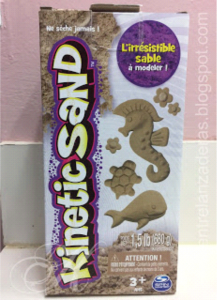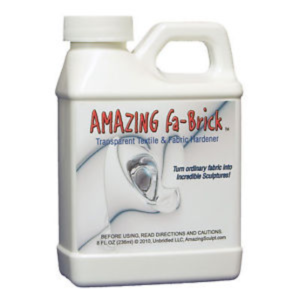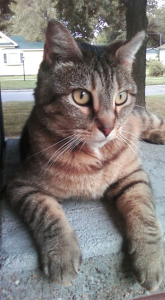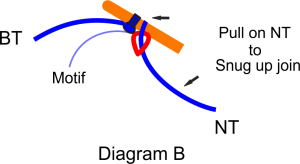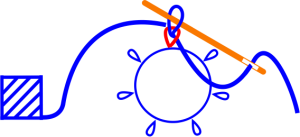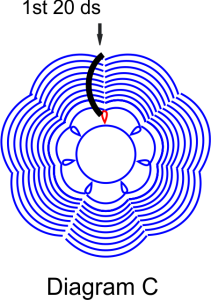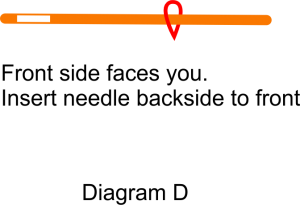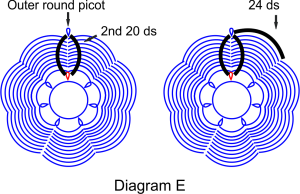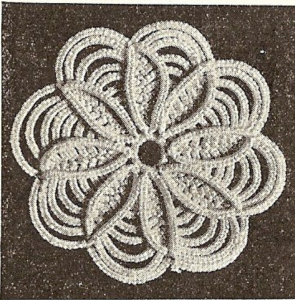Have your threads unravelled after you have cut and tied them to finish a project? To prevent unravelling, try the following. Cut and tie the threads in a square knot. Before trimming the tail ends of the knot, put a drop of fray block on top of the knot. Let it completely dry. Then trim the tail ends. This can help secure your ends.
Blog
Why use a shuttle winder?
The Lacis shuttle winder works with a 4.25″ Tatsy shuttle. You use it to wind thread on to your shuttle. And it helps to preserve the integrity of your thread. Let me explain.
Did you ever notice how a shoelace frays when it has been pulled through eyelets too many times? On a smaller scale, the same thing can happen with tatting thread. When you wind thread on to your shuttle, you force the thread between two blades. When the blades pinch the thread, there is a clicking sound. This disturbs or weakens the natural twist of the thread. In the following example, let’s call the weakened or pinched point, Section A. If your thread has aged, then the point at which it is more likely to break is Section A. Or if you use Section A for a join and because the thread twist has been disturbed, the crochet hook can easily split the thread, making your tatting less tidy.
The pinch is more apparent on larger sizes of thread such as size 10, 5, or larger. A thread winder helps you avoid these things. The winder is seated between the blades and functions like the contour of a bow pulling the blades apart. It leaves a thin space for the thread to pass through without touching the blades. No damage is done to your thread.
Kinetic Sand
Karen Cabrera posted on her blog about a wonderful new toy called kinetic sand. Karen gave me permission to share it with you. She created this little angel using kinetic sand.
Kinetic sand is like wet sand that sticks to itself.
You can mold it into any shape.
The sand does easily fall apart. See video.
To prevent the sand from losing its shape, just cover it with a plastic bag and mold it. When you achieve the correct shape, close the plastic bag and tape it to hold its shape. Make sure the bag is as smooth as possible.
Before placing your tatting on the mold, add plastic wrap to make the area even smoother. The smoother the plastic, the easier it is to remove the tatting without any trouble.
In the photo below, Karen used a cardboard tube wrapped in plastic wrap for the wings. (Never use Styrofoam when using Amazing Fa-Brick as a hardener.)
Note: The wings and the body were already joined with regular tatted joins before they were set on the molds.
Karen applied one coat of Amazing Fa-Brick. It dries clear and doesn’t stick to plastic. Its odor is no stronger than Elmer’s glue. It can be found here.
Before application, Karen likes to dampen the tatting to help it absorb this hardener. When it dries, it is as hard as vinyl tiles. If your tatting will be used outside, apply several coats, letting each dry in between applications. This creates a harder finished piece.
After 24 hours, the Amazing Fa-Brick dries. If you have applied the hardener correctly (read instructions on package), the tatting will not stretch when you remove it. You can pull away the plastic or gently slide a crochet hook between the tatting and plastic to lift off the tatting. The hardener may leave some residue which can be brushed away or removed with tweezers.
I am excited to try this. I hope you’ll give it a try. Have fun!
Story of Lady Vee Gray
One late afternoon I took a walk to our high school. Just before entering the school area, there is a sloped road. At the top of the slope was a black silhouette against the setting sun. The ears were exaggerated on a small head. It looked like a young rabbit. Silently, I walked towards it to get a closer look.
It heard me approach, stood up, and four thin legs unfolded beneath her. It was a little kitten! She started weaving in and out of my legs. I had to pick her up. She was so light and small I thought she must be about three months old.
When I got home, I fed her. Then she fell asleep on my lap. I named her Lady Vee Gray (as it turns out she is a polite lady). The next day I took her to the vet. She weighed 2.75 pounds. The vet identified six-month old teeth. (Later, we realized she was actually seven months old at the time.) The vet said if I hadn’t found her, Vee would not have lived through the weekend.
Despite her tenuous start, at eight years old, she still enjoys being outside. She has left bugs and leaves on my doorstep. (No wonder she was starving.) But she spends every night inside the house.
Free Needle Tatting Pattern
Tatted Daisy by Mrs. W. M. Odum.

Shared from a post on Pinterest
This pattern has extended instructions for the beginning needle tatter. If you need to find out what a term means: click on “Terms”, choose “Terms for Needle Tatting.”
Supplies
Crochet Thread (Size 10)
Tatting Needle (Size 7)
Crochet Hook (Size 8)
Picot Gauge (1/8″)
Small Scissors
Needle Threader
Abbreviation Key
ds = double stitch(es)
p = picot
Reverse Work: turn motif to its opposite side in a motion similar to opening or closing an oven
door.
Rotate Work: turn work like a bicycle wheel rotates, except you may go in clockwise
or counterclockwise direction. Do not turn motif to its opposite side.
Turn Work: to opposite side as if turning over a page.
Join
In this pattern “join” means: After the last double stitch of chain is made, do not close. The front side faces you. Insert crochet hook (front side to backside) through picot. Pull up needle thread (NT) from the backside to form a loop. Then insert needle (backside to front) through loop (Diagram A). This is the join. Pull on needle thread to snug up join. Then use the ball thread (BT) to make the required number of double stitches for the next chain (Diagram B).
Preparation
For Round 1: thread 5″ for tail end. Leave 7″ of Loop thread before making the first double stitch.
Round 1
Ring: 2 ds, p, 2 ds, p, 2 ds, p, 2 ds, p, 2 ds, p, 2 ds, p, 2 ds, p, 2 ds. (All 7 picots = 1/8″.)
Leave 4″ before cutting needle and ball threads. Tie in a square knot. (Optional: sew in ends.)
Round 2
Rethread needle as follows:
Thread needle with 44″ for the tail end.
Leave 46″ of Loop thread before making the first double stitch.
First make the join: pull up (back to front side) needle thread through picot to make a loop. Insert needle (back to front side).
Then make the chain according to the following instructions:
*Chain: 4 ds. Do not close. Join to next picot per instructions.*
Repeat from * to * around.
Round 3
*Chain: 6 ds. Do not close. Join to next picot per instructions.*
Repeat from * to * around.
Round 4
*Chain: 8 ds. Do not close. Join to next picot per instructions.*
Repeat from * to * around.
Round 5
In this round you will add a marker after completing the first chain. The marker is a 4″ piece of scrap thread. Tie or drape it over the newly completely chain. Then continue making chains of 10 double stitches all the way around.
*Chain: 10 ds. Do not close. Join to next picot per instructions.*
Repeat from * to * around.
After making the last chain in the current round, remove scrap thread. Make the first chain of the subsequent round. Tie on the marker.
Rounds 6-11
Continue making the chains and joining as usual. Just add 2 stitches to each chain for each additional round. (Hint: Round 6 has 12 double stitches. Round 11 has 22 double stitches.)
Round 12
(Last Round)
*Chain: Make 20 ds (Diagram C). Insert needle (back to front) through center picot (Diagram D). Do not close. Rotate work.
Chain: Make 20 ds. Insert needle (front to back this time) completely through picot on the outer round (Diagram E).
Chain: Make 24 double stitches on the outer round.* Repeat from * to * around.
Join last chain to first picot of the round. Cut and tie in a square knot.
Free Pattern
Tatted Daisy by Mrs. W. M. Odum. It is found here.
For your convenience, I rewrote the pattern so it is easier to read.
Supplies:
2 small Sew Mate shuttles (both full / add thread as needed)
Lizbeth Thread (Size 20)
Crochet Hook (Size 11)
Picot Gauge (1/8″) (.32 cm)
Abbreviations:
Ch = Chain
DS = Double Stitch(es)
J / + = Join
MP = Mock Picot
Rep = Repeat
RW = Reverse Work
R = Ring
Sh1 = Shuttle 1
Sh2 = Shuttle 2
Notes:
All picots = 1/8″ (.32 cm)
Join A: (Pull (backside to front) Sh1 thread to make a loop, insert (front to backside) Sh1 through loop.)
Join B: (Pull (backside to front) Sh2 thread to make a loop, insert (front to backside) Sh1 through loop.)
Round 1:
R: 2 – 2 – 2 – 2 – 2 – 2 – 2 / – (MP.) RW. (7 picots total.)
Round 2:
Ch: [4, + (j. to next picot of center ring), 4] (Rep. 7 times.) Join to first picot where you started.
Round 3:
Ch: Picot, 6, + (j. to next picot),
*6, + (j. to next picot)*
Rep. from * to * around.
Rounds 4 – 10: Same as Row 3.
Add 2 DS to each chain in the succeeding rows.
(Hint: Round 4 = 8 DS in each Ch and Round 10 = 22 DS in each Ch.)
Round 11: (Last Round)
Chain 20 DS, bring it across the top of the medallion to center.
Use Join A to make a join to first picot of center ring. Rotate work.
Chain 20 DS, carry chain to outer round.
Use Join A to make a join to starting point. Rotate work.
*Chain 24, use Join B to make a join to the next picot on the outside round.
Chain 20, use Join A to join to next picot of center ring.
Chain 20, use Join A to make a join to the starting point.*
Repeat from * (Chain 24) to * around.
After you have made last chain of 24 DS, leave 3-4″ (7.6 – 10 cm) of Sh1 and Sh2 threads. Cut threads.
Use a crochet hook to pull Sh1 thread (front to backside) down through first picot of the first chain on outside round.
Tie Sh1 and Sh2 threads in a square knot. Or finished using your preferred method.
Note: In Round 11, I used 23 double stitches instead of 24. I thought this made the space between the last round and previous rounds look equal in size. In other words, adding 24 DS made the space between the previous chain and the last outer chain appear larger than normal.
If you need to know what a term means, click here. Then click on “Shuttle Tatting.” Scroll down to click on the term in question.
Threaded Thoughts
I love quilting (mostly as an admirer) and tatted lace, but beneath the beads and baubles is the basis of our craft—thread. Harriet Hargrave’s book, From Fiber to Fabric: The Essential Guide to Quiltmaking Textiles has an entire section dedicated to thread.
Did you know thread can be balanced or unbalanced? Balanced thread hangs in a U-shape. This produces a smooth fabric. Unbalanced thread will untwist, then retwist on itself creating a textured fabric like crepe.
Another property of thread is the amount of twist in it: low, medium, or high. Fine threads need a high twist, 30-40 twists per inch, to make them strong. Medium twist gives warp thread its maximum strength. Threads with low twist are used in fabric with nap like corduroy. The low twist makes it easier for machines to tease out the fibers.
The chosen fabric determines which thread is best. The strongest thread is not always the best. Strong thread which is highly twisted sets the fibers at right angles. This works like a saw, cutting against the fabric. The best thread to sew with is weaker than the fabric in which it is used. The fabric can move and flow without being caught up by a single thread.
It is a comfort to know, on those off-balance days when things aren’t going well and my response to a situation is worse, it is okay if I am not the strongest person in the fabric of life. I will live another day to tat.
My Craft Projects
One of the reasons I learned to tat is to help ensure this method of lace making is practiced by future generations. I think tatting can enhance the beauty of any project. Tatting has been added to crochet, used by scrapbookers, placed in oil paints and used in grand scale art installations. I tend to add tatting to my fabric art and quilts.
The following quilt block is another one of my UFOs. Originally, it was made to enter a contest. I never got back to it. The circle is made of simple tatted rings. A bare thread space was substituted for chains. I wrote the little saying in the center and embroidered it. And oh, I didn’t win. But I did get my block back which makes me feel like I won a finely embroidered quilt block.
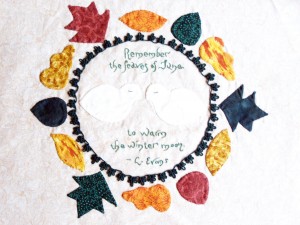
This leads me to my next three pieces. One of my favorite verses is appropriate for all needle workers: tatters, embroiderers, lace makers, and quilters, etc.
“From the fruit of the mouth one is filled with good things and manual labor has its rewards.” Prov. 12:14 (RSV)
This little pink girl is surrounded by a flurry of free form tatted flowers. She is feeding baby chicks. When I was growing up the adult chickens would flock out to be fed while the chicks were more timid. The baby chicks were cute. The adult chickens would chase me and try to peck me. In the end, I was afraid of (chicken) of chickens.
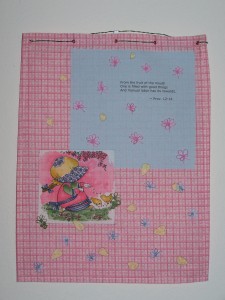
I was inspired to create more fabric art after reading Fabric Art Collage: 40+ Mixed Media Techniques by Rebekah Meier. (I got this book for free because I traded some old books for store credit at Hastings Bookstore. It pays to recycle.)
In the Path of Life artwork, both the grass and the imaginary plant are tatted. The verse written on the quilt is Ps. 16:11.

Teach Me Your Ways has tatting at the top, left hand corner. I used three colors of Paintstik oils to draw the curved designs on the right side of this piece of fabric art. The written verse is Ps. 86:11.
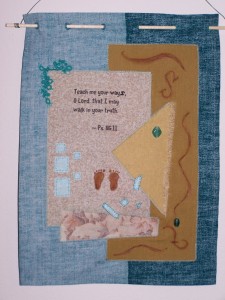
Dresden Flower
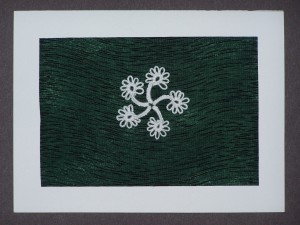
First Shuttle Tatting Class
Last month I taught my first tatting classes. Sixteen wonderful women attended. I want to publicly thank them for taking a Beginning Tatting class.
I spent several months writing my lesson plans and preparing my samples. I was so pleased (if not somewhat surprised) when the plans actually worked! The women were amazing in how quickly they learned to make the double stitch.
The other thing I learned is how much I enjoyed teaching women. (I have taught children for about 24+ years.) One woman, without any knowledge of tatting, joined the class only because a friend brought her along. By the end of class, she had adopted tatting as her new passion.
Tatting is the only needle art I was unable to learn by reading a book. (I learned knitting, crochet, hardanger, cross stitch, and Mountmellick embroidery by reading various books.) When I began tatting, I was unaware of any tatting videos on the Internet. Instead, I read several tatting books. In these books, the double stitch “flip” was often indicated by an arrow. I did not understand what the arrow meant. I thought “reverse work” meant: turn to its opposite side.
Then I saw a live tatting demonstration. Finally, I understood how to make the “flip.” This motion looked like a tiny jump rope–swung up your backside and halted above the head. Or, in tatting terms, to make the flip the shuttle thread is transferred from below the left hand thread to above the left hand thread.
Anyway, I want to thank you again, ladies, for taking my classes. I hope to meet you again in future classes.
Tatting Club
Lincoln Lacemakers
Valhalla Honey Lace
4713 Hartley Suite 2
Lincoln, NE
Owner: Jane Nelson
Date: 1st Tuesday of each month*
Time: 7:00 pm – 9:00 pm
Jane says there is no need to call in advance. Just come on over and try a meeting or two. Each meeting includes a program.
* If this date is rescheduled, they will let their members know.

